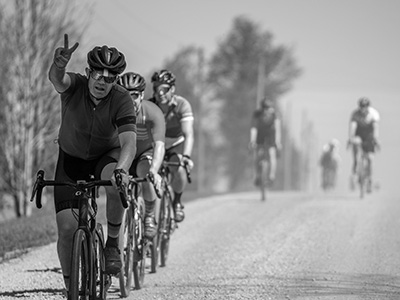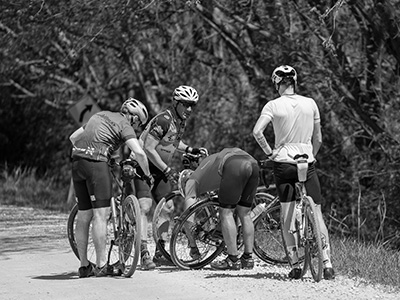June 27, 2022
By molly hurford
So you’ve signed up for a gravel race… but you’ve never raced gravel before. Maybe you’ve dabbled in road, mountain biking or cyclocross, but a 100-kilometre or 100 mile gravel race is a different animal. Here’s what you need to know to have a fun, successful gravel race:
Study the course map, profile and details
It’s always helpful to know what you’re getting into, and gravel racing is a particular type of beast. Distance is an important component, but so is the elevation loss and gain, and the course description regarding how much of the race is on gravel roads, paved roads, double track and single track. The definition for gravel racing is quite loose, so some races maybe 80 percent road with chunks of gravel and trail, while others are almost entirely run on double track with a smattering of road.
There may be a river or creek crossings on course, and those are worth knowing about and anticipating. Do your homework by reading everything on the race website, but also do a quick search for blogs, videos and stories from past races on the same course.

Practice Gravel Skills

Technical skills may not seem like an important aspect of gravel racing, but the smoother you can take gravel corners or descend on chunky gravel downhills, the better your race day will go.
You don’t need to spend all of your time training on gravel or on single track with your gravel bike, but a few minutes spent on gravel riding skills will pay off hugely on race day.
Ask for Gear Advice
Not sure what tires to run, or what pressure to run them at? Confused about gravel gearing? Not sure which shoes to wear, road or mountain? Debating hydration pack versus bottles? There are so many questions when considering what to run for a gravel race, and if you’re new to the sport, it’s intimidating. It’s also all part of the fun and what makes gravel such a dynamic sport!
Reach out to race organizers for event-specific advice, or see what riders have used in past years. Ask at a local bike shop, or ask your gravel racing friends for tips. While you can race gravel on anything, if you can go in with a setup that makes you feel confident, that’s going to make your day better.
Respect the Distance
Be Ready for the mass start
We’ll say it again, but gravel distance is not the same as road distance. If you’ve ridden 100 kilometers on the road, you likely have a rough idea of how long that jaunt takes you. 100 kilometers of gravel—especially in some of the races that include chunks of single track or even hike-a-bike sections where almost everyone will be off and walking—can take hours longer than your speedy, smooth 100 kilometers of pavement. Additionally, gravel races rarely contain pelotons of people, so you’ll be doing more work than you would in a standard road ride or race. Assume that a gravel race will take about 15 to 25 percent longer than a road race with similar elevation, and plan accordingly.
The beauty of gravel events is that they’re almost always mass participation events with a single start, or maybe a few mixed waves. This can be intimidating for newer riders, so if you’re not trying to win the race, feel free to start at the back and take it easy as the race gets going. If you are hoping to be in the mix, just be aware that the start will feel more challenging and much harder than the rest of the race, but once you’ve been rolling for a few minutes, everyone will settle into a more reasonable pace.
Embrace the aid stations
Aid stations are half the fun of gravel racing, so make sure to take advantage of them, especially if you’re out for a fun day and good experience rather than a podium position. While trying new foods is always risky on race day, often aid stations are packed with fun snacks, from gummy bears to salted potatoes to pickles, so graze a bit, especially if you have flavour fatigue from your usual gels. And make sure you’re taking the opportunity to fill up your bottles or hydration pack when you notice it’s getting low!
BYOTOOLS
Draft When You Can
You will have to fix your own bike if something goes wrong during these races, and with how many courses are set up, if you can’t fix your bike, it could be many kilometres of walking before you hit an aid station or are able to flag down a car or call for a ride. That’s why having tools to fix a flat and do basic bike repair are critically important. And yes, flats still happen with tubeless tires and you can’t always plug them, so always have a spare tube on hand—and make sure you have the right tool to take your wheel off of your bike to change it, since many newer thru axle models require an Allen key to remove the wheel.
If you’re comfortable drafting, gravel races are a great place to sit back and enjoy a ride when you can get it. Unlike road races, you won’t be trying to stay in a big pack the entire time, but you can take advantage of jumping onto someone’s wheel for a few kilometers, especially in the less technical parts of the race. Even if you can’t hold someone’s pace for long, take a bit of extra speed when you can. It will save you energy in the long run.
Plan to be gone all day
Give yourself a time buffer when planning to be gone for a gravel race. Gravel race times are hard to guess: Even compared to past years results, weather and course conditions can completely change how easy or hard the ride is. Flats are common, and you may decide you want to linger at aid stations.
Not only do gravel races take a long time—a 100 mile gravel race could take a couple hours longer than a road race of the same distance—but there’s often plenty of hanging out at the finish line. Gravel races have created strong communities, so if you’re hoping to make friends in cycling, a gravel race and subsequent finish line hangout is a fantastic way to chat with new potential riding friends.
About the Author
Molly Hurford is a journalist in love with all things cycling, running, nutrition and movement-related. When not outside, she’s writing about being outside and healthy habits of athletes and interviewing world-class athletes and scientists for The Consummate Athlete podcast and website, and most recently launched the book ‘Becoming A Consummate Athlete.‘ She’s the author of multiple books including the Shred Girls, a young adult fiction series and online community focused on getting girls excited about bikes.
Molly is a little obsessed with getting people psyched on adventure and being outside, and she regularly hosts talks and runs clinics for cyclists and teaches yoga online and IRL… And in her spare time, the former Ironman triathlete now spends time tackling long runs and rides on trails or can be found out hiking with her mini-dachshund DW and husband, cycling coach and kinesiologist Peter Glassford.
